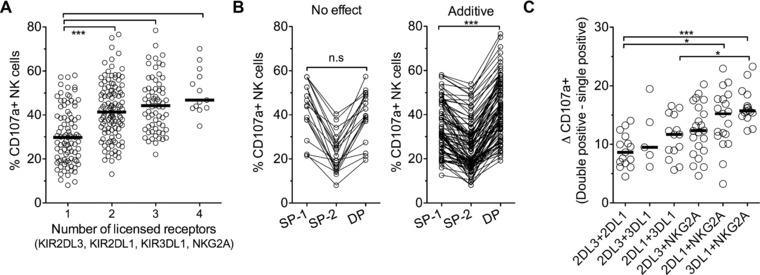Figure 3.

KIR3DL1 and NKG2A combine for greater additive licensing impact than KIR2DL3 and KIR2DL1. (A) Degranulation (CD107a) of NKC subsets expressing 1, 2, 3, or 4 licensing receptors (KIR2DL3, KIR2DL1, KIR3DL1, and NKG2A), from 29 volunteers, previously defined as licensed due to the presence of their respective ligands. (B) Functional responsiveness of double‐positive (DP) NKC were additive (right) or had no effect (left) compared with contributing single positive (SP) subsets (SP‐1 and SP‐2). SP‐1 had greater function of each pair, regardless of receptor identity. No effect was defined as CD107a(DP) ≤ (SP‐1), additive as CD107a(DP) > (SP‐1). Connected lines indicate populations from the same donor. (C) Net degranulation of DP NK subsets defined as additive in Figure 3B stratified by all six combinations of KIR2DL3, KIR2DL1, KIR3DL1, and NKG2A. Degranulation of each SP subset (SP‐1 and SP‐2) was deducted from each DP subset separately, resulting in two values of which the mean was taken and plotted. Black line = median for each group. Each circle shows one donor with indicated receptor expression, horizontal black lines show median values for each group. Data are from all 29 healthy volunteers. Each circle shown is one individual with mean %CD107a+ from triplicate degranulation assays minus value from PBMCs alone from a single individual with indicated receptor expression. Data shown are from 29 independent healthy control individuals. Kruskal–Wallis test with Dunn's multiple comparison test,*p < 0.05; **p < 0.01; ***p < 0.001, n.s: not significant.
